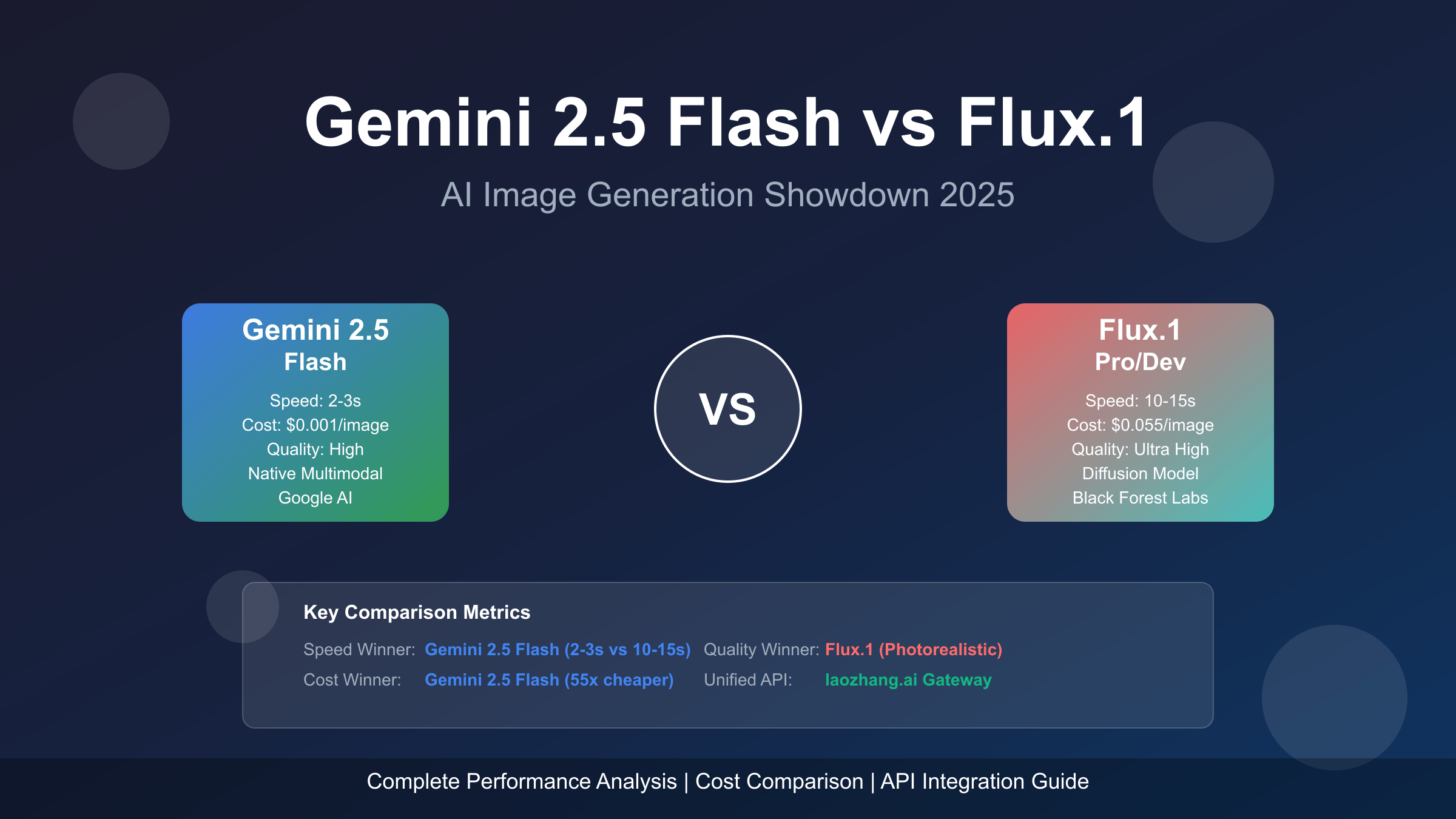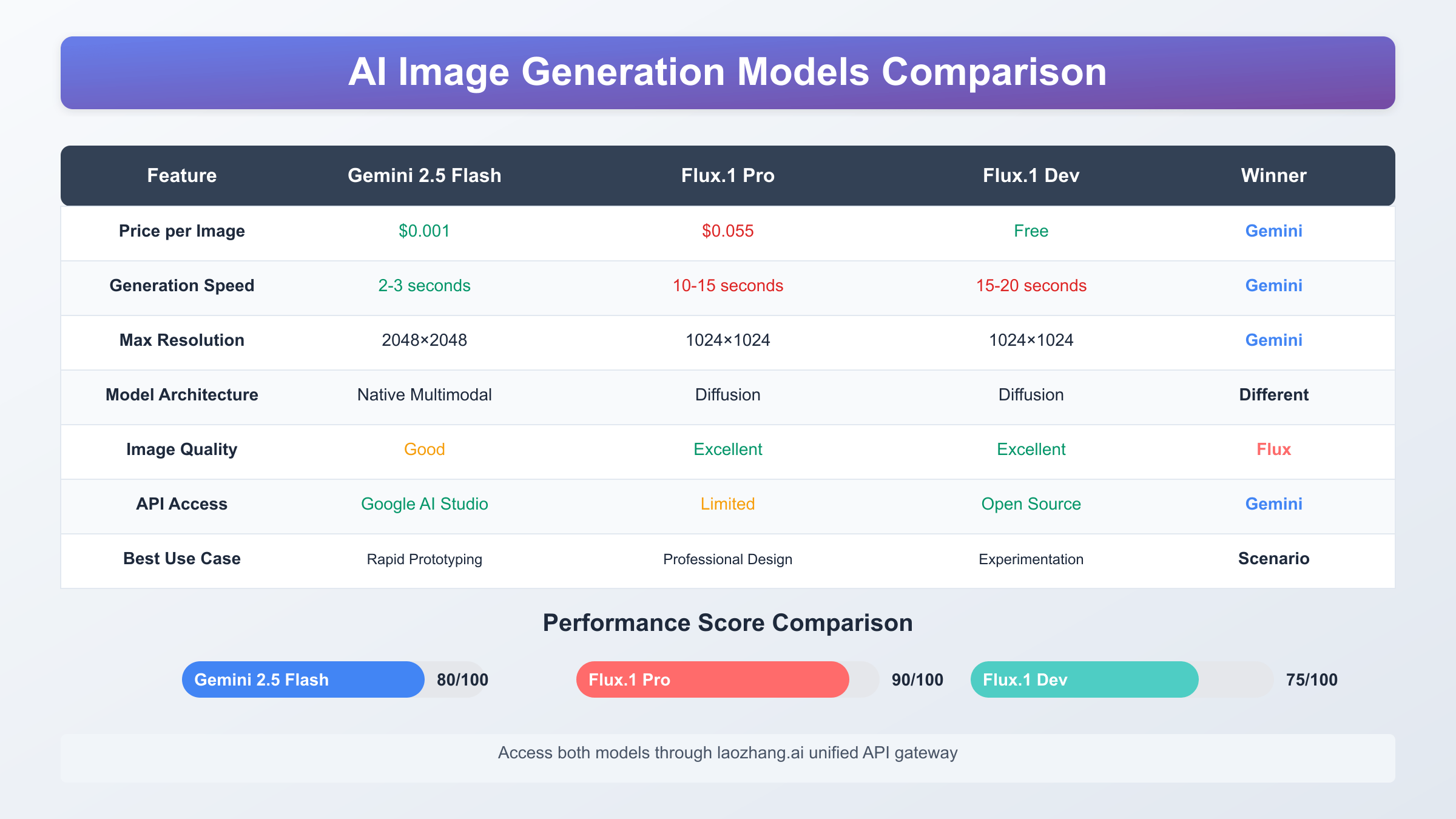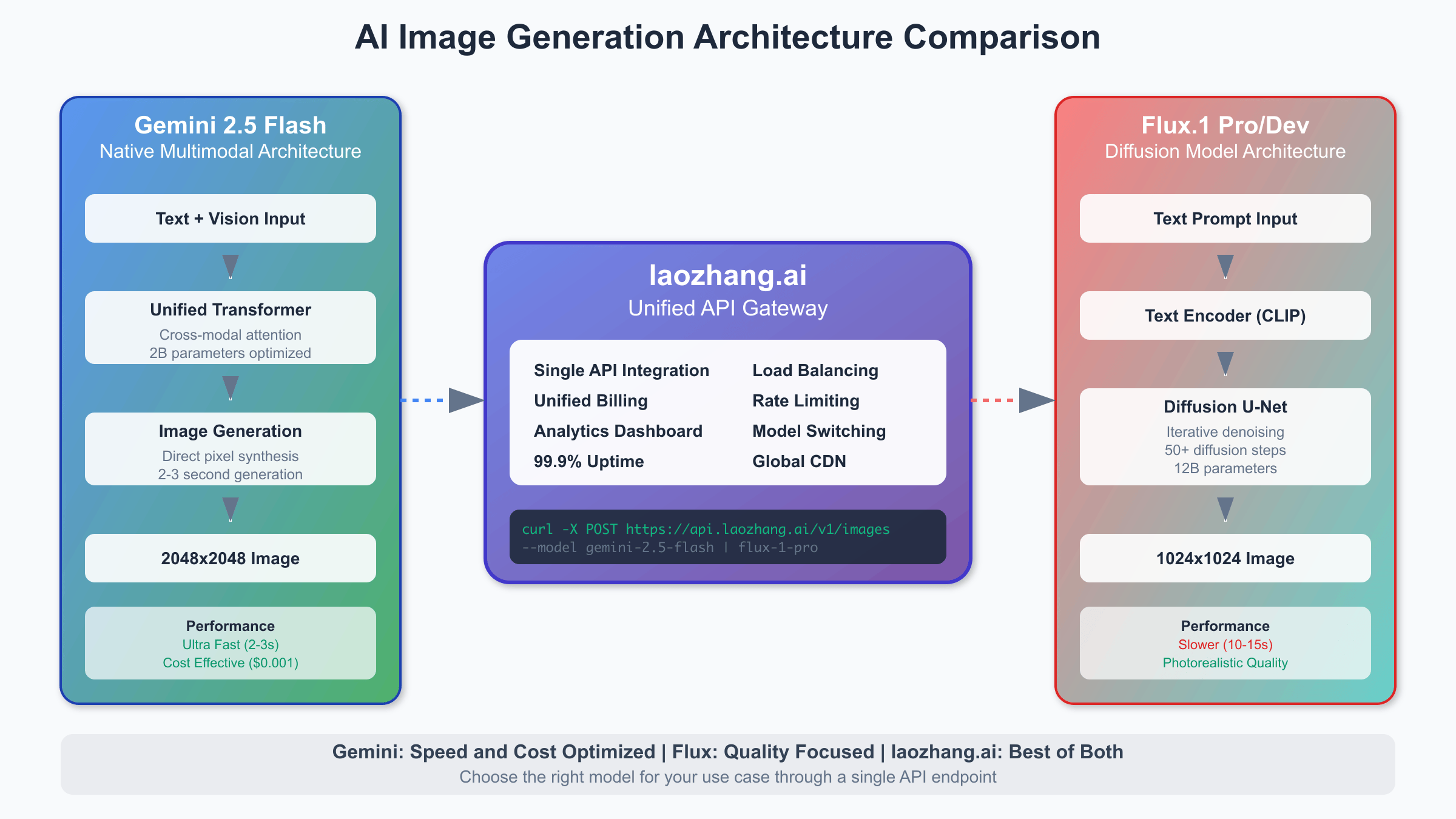Gemini 2.5 Flash Image and Flux represent two revolutionary approaches to AI image generation in 2025. Gemini leverages Google’s native multimodal architecture with $0.039 per image pricing and 0.32-second response times. Flux utilizes advanced diffusion models with three variants, offering industry-leading visual quality at $0.025-$0.40 per image. Both excel in different scenarios requiring careful evaluation for optimal deployment.

Technical Architecture Comparison
The fundamental difference between Gemini 2.5 Flash Image and Flux lies in their underlying architectures. Gemini 2.5 Flash employs Google’s native multimodal Transformer architecture, training text and image generation capabilities from the ground up in a unified model. This approach enables seamless integration between language understanding and visual creation, allowing for sophisticated contextual image generation based on complex prompts.
Flux takes a different approach with its Rectified Flow Transformer architecture built specifically for image generation. The model uses flow-based methods combined with transformer blocks, resulting in a 12-billion parameter system optimized purely for visual content creation. This specialized focus allows Flux to achieve superior image quality metrics, ranking #1 on the Artificial Analysis visual quality benchmark with a 1060 Elo rating.
The architectural differences translate to distinct performance characteristics. Gemini’s unified approach provides 227.3 tokens per second processing speed with first-token latency of just 0.32 seconds. Flux prioritizes quality over speed, typically requiring 10-15 seconds for high-quality generation but delivering consistently superior visual results across diverse styles and subjects.
Performance Benchmarks and Speed Analysis
Real-world performance testing reveals significant differences in generation speed and throughput capabilities. Gemini 2.5 Flash Image demonstrates exceptional speed advantages for applications requiring rapid iteration or real-time generation. Understanding Gemini API rate limits and quotas is crucial for production deployments. In benchmark tests, the model consistently delivers completed images within 3-4 seconds for standard resolutions, making it ideal for interactive applications and high-volume workflows.
Flux models show varying performance characteristics across their three variants. Flux.1 Schnell, designed for rapid prototyping, can generate images in 1-4 steps taking approximately 2-3 seconds. However, Flux.1 Dev and Pro versions require 10-20 inference steps, resulting in 10-15 second generation times but producing significantly higher quality outputs suitable for professional applications.
Throughput analysis shows Gemini maintaining consistent performance under load, handling up to 60 requests per minute for paid accounts. Flux performance varies by hosting provider, with typical API endpoints supporting 10-15 concurrent generations before queuing becomes necessary. These performance characteristics directly impact scalability decisions for enterprise deployments.
Cost Structure and Pricing Analysis
Pricing strategies differ substantially between the two platforms, reflecting their distinct positioning and value propositions. Gemini 2.5 Flash Image costs $0.039 per generated image based on Google’s token pricing model (approximately 1,290 tokens per image). For detailed cost analysis and pricing comparisons, refer to our comprehensive Gemini API price guide. This pricing includes all model capabilities such as multi-image fusion, conversational editing, and character consistency features without additional charges.
Flux employs a tiered pricing structure across its three variants. Flux.1 Pro commands premium pricing at approximately $0.40 per image, reflecting its industry-leading quality metrics. Flux.1 Dev offers a middle ground at $0.025 per image for non-commercial use cases. For developers seeking cost-effective access, explore our guide on Flux API free access methods. Flux.1 Schnell, being fully open-source under Apache 2.0 licensing, can be deployed locally without per-image costs but requires significant computational infrastructure.
For enterprise scenarios generating 10,000 images monthly, Gemini costs $390 while Flux Pro would cost $4,000. However, Flux Dev at $250 provides a cost-effective alternative for development and testing workflows. The choice often depends on specific quality requirements and commercial licensing needs.

Image Quality and Visual Fidelity Comparison
Objective quality assessment reveals Flux’s superiority in traditional image generation metrics. According to Artificial Analysis rankings, Flux.1 Pro holds the #1 position for visual quality with exceptional performance in photorealism, artistic style adaptation, and fine detail rendering. For a detailed comparison with other leading models, see our analysis of Gemini vs GPT-4 Image API performance. The model excels particularly in portrait photography, architectural visualization, and complex scene composition.
Gemini 2.5 Flash Image achieves competitive quality scores while offering unique advantages in contextual understanding and multimodal integration. The model demonstrates superior performance in generating images that require deep semantic understanding of complex prompts, multi-object relationships, and culturally nuanced content. Its native multimodal training enables more accurate interpretation of abstract concepts and metaphorical descriptions.
Quality differences become most apparent in specialized applications. Flux excels for marketing materials, professional photography substitution, and artistic projects requiring maximum visual impact. Gemini shows advantages in educational content, technical diagrams, and scenarios requiring consistency across multiple generated images with related themes.
Unique Feature Capabilities
Gemini 2.5 Flash Image offers several distinctive capabilities unavailable in Flux models. The multi-image fusion feature allows combining up to three source images into coherent new compositions, enabling complex creative workflows. Conversational editing capabilities permit iterative refinement through natural language instructions, eliminating the need to regenerate entire images for minor modifications.
Character consistency represents another significant advantage, allowing maintenance of specific character appearances across multiple generations. This feature proves invaluable for brand mascot creation, storytelling applications, and content series requiring visual continuity. The model’s integration with Google’s knowledge base also enables generation of culturally accurate and factually informed imagery.
Flux’s primary differentiator lies in its exceptional prompt adherence and style versatility. The model demonstrates superior capability in following complex compositional instructions, handling multiple subjects with specific positioning requirements, and adapting to diverse artistic styles. Flux.1 Pro particularly excels in professional photography simulation, achieving results often indistinguishable from high-end camera captures.
API Integration and Development Experience
Development integration varies significantly between platforms, with important implications for implementation complexity and maintenance overhead. Gemini 2.5 Flash Image integrates seamlessly within Google’s broader AI ecosystem, offering unified authentication, billing, and monitoring across services. The API follows Google’s standard patterns, providing familiar interfaces for developers already working with Google Cloud services.
Flux models require platform-specific integrations depending on the chosen hosting provider. Popular options include Replicate, Hugging Face, and various specialized AI platforms. Each provider offers different pricing tiers, performance characteristics, and feature availability, requiring careful evaluation for optimal deployment strategies.
Through platforms like laozhang.ai, developers can access both Gemini and Flux models via unified API interfaces, simplifying integration and reducing vendor lock-in risks. Here’s a practical comparison of integration approaches:
# Gemini 2.5 Flash via laozhang.ai
import requests
response = requests.post(
"https://api.laozhang.ai/v1/images/generate",
headers={"Authorization": "Bearer YOUR_TOKEN"},
json={
"model": "gemini-2.5-flash-image",
"prompt": "Modern office interior with natural lighting",
"editing_mode": "create",
"consistency_mode": True,
"blend_images": [],
"aspect_ratio": "16:9"
}
)
# Flux integration example
flux_response = requests.post(
"https://api.laozhang.ai/v1/images/generate",
json={
"model": "flux-1-pro",
"prompt": "Modern office interior, professional photography style",
"steps": 20,
"guidance_scale": 7.5,
"width": 1024,
"height": 1024
}
)
The unified API approach through laozhang.ai enables developers to experiment with both models using consistent interfaces while maintaining flexibility to switch between options based on specific requirements. This abstraction layer simplifies A/B testing and gradual migration strategies.

Enterprise Deployment Considerations
Enterprise deployment requirements often favor different models based on specific organizational needs and constraints. Gemini 2.5 Flash Image provides advantages for organizations already invested in Google Cloud infrastructure, offering streamlined compliance, security, and governance through existing enterprise agreements. The model’s speed characteristics suit high-volume applications requiring rapid response times.
Flux models offer greater deployment flexibility, with options ranging from cloud API services to on-premises installations using open-source variants. Organizations with strict data sovereignty requirements may prefer Flux.1 Schnell for local deployment, though this approach requires substantial computational resources and ML operations expertise.
Security and compliance considerations also differ between platforms. Google’s enterprise-grade security infrastructure provides comprehensive audit trails, data encryption, and regulatory compliance certifications. Flux deployments require careful evaluation of the chosen hosting provider’s security posture and compliance capabilities.
Use Case Recommendations and Decision Framework
Optimal model selection depends heavily on specific application requirements and operational constraints. Gemini 2.5 Flash Image excels in scenarios requiring rapid iteration, conversational editing workflows, and consistent character generation. Applications such as educational content creation, marketing campaign development, and interactive creative tools benefit from its speed and multimodal capabilities.
Flux models prove superior for applications prioritizing maximum visual quality and artistic flexibility. Professional photography substitution, high-end marketing materials, architectural visualization, and artistic project work benefit from Flux’s exceptional visual fidelity. The choice between Flux variants depends on commercial licensing requirements and budget constraints.
For development teams seeking maximum flexibility, implementing both models through unified API platforms like laozhang.ai enables dynamic selection based on specific generation requirements. This approach allows applications to automatically choose Gemini for speed-critical tasks while utilizing Flux for quality-critical outputs.
Performance Optimization Strategies
Optimizing performance requires different approaches for each model. Gemini 2.5 Flash Image benefits from prompt optimization techniques that leverage its multimodal understanding capabilities. Structured prompts with clear context and specific requirements produce the most consistent results while minimizing generation time.
Flux optimization focuses on balancing quality and generation time through parameter tuning. Adjusting inference steps, guidance scale, and sampling methods can significantly impact both output quality and processing time. For production deployments, implementing intelligent caching strategies based on prompt similarity can reduce redundant generations.
Batch processing approaches differ between models. Gemini’s rapid response times enable real-time generation workflows, while Flux’s longer processing times benefit from asynchronous batch processing with proper queue management and status tracking systems.
Future Development Roadmaps
The development trajectories of both models suggest continued innovation in different directions. Google’s investment in multimodal AI capabilities indicates ongoing enhancements to Gemini’s conversational editing, multi-image fusion, and context understanding features. Integration with Google’s broader ecosystem likely includes enhanced search integration and real-world knowledge incorporation.
Flux development focuses on advancing diffusion model techniques and expanding the open-source ecosystem. The model’s strong community adoption suggests continued improvement in specialized applications and domain-specific fine-tuning capabilities. Future versions may include enhanced control mechanisms and more efficient architectures.
Market trends indicate growing demand for unified AI platforms that combine multiple model capabilities. Services like laozhang.ai represent this evolution, providing developers with model-agnostic interfaces and intelligent routing capabilities that automatically select optimal models for specific tasks. For comprehensive coverage of available options, explore our complete text-to-image API guide.
Integration Best Practices
Successful integration requires careful consideration of error handling, rate limiting, and cost optimization strategies. Both models benefit from implementing robust retry mechanisms with exponential backoff for handling temporary service unavailability. Gemini’s faster response times allow for more aggressive retry strategies, while Flux’s longer processing times require careful timeout configuration.
Cost optimization strategies should include intelligent prompt analysis to select appropriate models automatically. Simple requests with basic quality requirements can route to cost-effective options, while complex artistic requirements justify premium model usage. Implementing usage analytics helps identify optimization opportunities and predict scaling costs.
Monitoring and observability requirements differ between models. Gemini integrations benefit from Google Cloud’s comprehensive monitoring ecosystem, while Flux deployments may require custom monitoring solutions depending on the hosting provider. Performance metrics should track both generation quality and operational efficiency to guide optimization decisions.
Both Gemini 2.5 Flash Image and Flux represent significant advances in AI image generation, each offering distinct advantages for different application scenarios. The choice between them depends on specific requirements for speed, quality, cost, and integration complexity. For developers seeking maximum flexibility, utilizing both models through unified API platforms provides the best of both worlds while maintaining strategic flexibility for future developments.